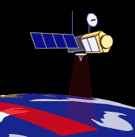Features
Judging the Ocean by Its Cover
03.10.05
| Who Are NASA's Earth Explorers? The elementary school student questioning if El Niño occurs anywhere besides the Pacific Ocean. The researcher investigating connections between Arctic ozone depletion and global climate change. The citizen scientist interested in how changing land cover and use affects animal migration patterns. And the businessperson projecting future needs for harvest, delivery and storage of crops. All of these people are Earth Explorers -- they are all connected by their curiosity about Earth system processes. This monthly series will introduce you to NASA Earth Explorers, young and old, with a variety of backgrounds and interests. Nominate an Earth Explorer! Tell us about the Earth Explorers you know. We're looking for students, teachers, scientists and others who are working with NASA Earth science data and imagery to better understand our home planet. Send your nominations to Dan Stillman: dan_stillman@strategies.org. |
Exploring the ocean is easier said than done. The atmosphere is an open book compared to the deep, dark waters that cover about 70 percent of Earth. Look up on a clear day and you can see all the way to the Sun with the naked eye. But stare as long and hard as you want at the ocean and you still can't see much past the water's surface.
The inability to easily observe the ocean is, in part, what makes it so mysterious and fascinating. Yet, with the help of satellites in space, scientists like NASA's Lee-Lueng Fu have managed to uncover many of the ocean's secrets by looking at its surface alone.
 |
Image to left: Lee-Lueng Fu works with NASA's TOPEX/Poseidon and Jason-1 to better understand the ocean's role in our climate. Credit: NASA
Sea surface height reveals more about the ocean than you might think. It can be used to calculate the amount of heat stored in the ocean -- water expands when it heats up, causing sea level to rise, and contracts as it cools, causing sea level to fall -- and to estimate the speed and direction of ocean currents. This information is important for monitoring and predicting phenomena such as hurricanes, global warming, and El Niño and La Niña, the cyclical warming and cooling of waters in the equatorial Pacific that affects weather patterns across the globe.
"We can monitor the evolution of El Niño and La Niña as they unfold with power to wreck havoc around the world," Fu said.
Thanks to satellites, Fu and his colleagues are also learning more about tsunamis, after both TOPEX/Poseidon and Jason-1 measured the height of the waves associated with December's deadly tsunami in the Indian Ocean.
"It's hoped that these data will help with the prediction of tsunamis and revealing more details of the earthquakes that cause them," Fu said.
 |
There are other benefits to thorough and accurate observation of the ocean, too. Maps of ocean currents help with ship navigation, fishing and tracking of water pollutants, while ocean heat data is critical to forecasting small- and large-scale changes in weather and climate.
It wasn't so long ago that we knew a lot less about the ocean and its relationship with other parts of the Earth system. The first ocean-observing satellite, NASA's Seasat spacecraft, was launched in 1978. Because the oceans are so massive, and many waters so remote, comprehensively monitoring them was difficult before the advent of satellites, according to Fu.
"It takes a ship weeks to cross the Pacific, while it takes only tens of minutes for a spacecraft to do the same," he said. "From space, we can watch the change in the ocean as it happens, while in the past measurements taken at sea have taken too much time to reveal the fast changes in the ocean."
Advances in ocean research have also been brought about by international partnerships. The TOPEX/Poseidon and Jason-1 missions are conducted jointly by NASA and the French Space Agency, and Fu, located at NASA's Jet Propulsion Laboratory in Pasadena, Calif., works with scientists from France, Japan, the United Kingdom and other nations. The opportunity to interact with colleagues in different countries is what Fu says he enjoys most about his work.
"Science has been among the best bridges connecting people from all over the world," Fu said. "International collaboration is the most effective way to share different perspectives."
Where Are They Now?
You might just be able to see TOPEX/Poseidon or Jason-1 yourself. Follow the directions at Where are They Now? to find out where the satellites are located and when they can be viewed from your area.
See previous Earth Explorers articles:
+ View site
Related Resources
Ocean Surface Topography From Space
+ View site
OceanWorld
+ View site